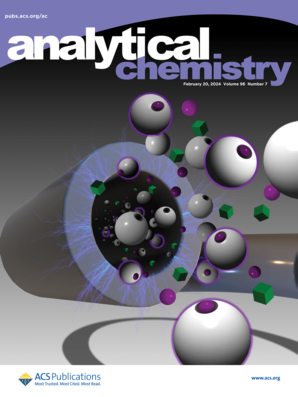基于1,6-萘啶衍生物的极性敏感荧光探针鉴别正常和癌变组织的简便方法
IF 6.7
1区 化学
Q1 CHEMISTRY, ANALYTICAL
引用次数: 0
摘要
癌症是由多种因素长期相互作用引起的遗传性疾病,已成为夺走人类健康的最重要因素;因此,有必要开发一种更高效、更灵敏的癌症检测技术。本研究开发了两种基于1,6-萘啶部分的极性敏感探针1a和1b,该部分通过乙烯基作为π桥与不同的靶向基团连接。随着溶剂极性的降低,探针1a和1b的发射波长发生了蓝移,导致荧光强度分别显著增强了135倍和53倍,探针1a、1b的Fmax与Δf之间建立了良好的线性关系,相关系数很高。此外,探针1a和1b表现出较大的斯托克斯位移、较高的光稳定性和较低的细胞毒性,成功靶向细胞内脂滴和线粒体。通过脂滴和粒线上探针荧光强度的实时变化检测到极性的波动。此外,探针1b能够在饥饿或雷帕霉素诱导的自噬过程中实时监测线粒体极性。值得一提的是,1a和1b可以区分正常细胞和癌症细胞,然后探针也成功应用于成像,区分人类正常组织和癌组织,恶性肿瘤组织的荧光强度比正常组织高15.4–19.9倍,比良性肿瘤组织高5.3–7.2倍。因此,本研究为癌症诊断提供了潜在的应用。本文章由计算机程序翻译,如有差异,请以英文原文为准。

Facile Way to Differentiate Normal and Cancerous Tissues via Polarity-Sensitive Fluorescent Probes Based on 1,6-Naphthyridine Derivatives
Cancer is a genetic disorder caused by the long-term interaction of many factors, which has become the most important factor to take away human health; therefore, it is essential to develop a more efficient and sensitive cancer detection technology. This study developed two polarity sensitive probes 1a and 1b based on a 1,6-naphthyridine moiety linked to different targeting groups by vinyl as the π bridge. As the solvent polarity decreased, the emission wavelength of probes 1a and 1b experienced a blue shift, resulting in a significant enhance in fluorescence intensity by 135-fold and 53-fold, respectively, and a good linear relationship between Fmax of probes 1a and 1b and Δf was established with high correlation coefficients. Furthermore, probes 1a and 1b exhibited large Stokes shifts, high photostability, and low cytotoxicity, successfully targeting intracellular lipid droplets and mitochondria. Fluctuation in polarity was detected by real-time changes in fluorescence intensity of probes in lipid droplets and mitochondria. Moreover, probe 1b was capable of real-time monitoring mitochondrial polarity during starvation or rapamycin-induced autophagy. It was worth standing out 1a and 1b could distinguish normal cells from cancer cells, and then the probes also were successfully applied for imaging to differentiate between human normal tissues and cancerous tissues, with the fluorescence intensity of malignant tumor tissues being 15.4–19.9 folds higher than that of normal tissues and 5.3–7.2 times higher than that of benign tumor tissues. Therefore, this research offers potential applications for cancer diagnosis.
求助全文
通过发布文献求助,成功后即可免费获取论文全文。
去求助
来源期刊

Analytical Chemistry
化学-分析化学
CiteScore
12.10
自引率
12.20%
发文量
1949
审稿时长
1.4 months
期刊介绍:
Analytical Chemistry, a peer-reviewed research journal, focuses on disseminating new and original knowledge across all branches of analytical chemistry. Fundamental articles may explore general principles of chemical measurement science and need not directly address existing or potential analytical methodology. They can be entirely theoretical or report experimental results. Contributions may cover various phases of analytical operations, including sampling, bioanalysis, electrochemistry, mass spectrometry, microscale and nanoscale systems, environmental analysis, separations, spectroscopy, chemical reactions and selectivity, instrumentation, imaging, surface analysis, and data processing. Papers discussing known analytical methods should present a significant, original application of the method, a notable improvement, or results on an important analyte.
 求助内容:
求助内容: 应助结果提醒方式:
应助结果提醒方式:


